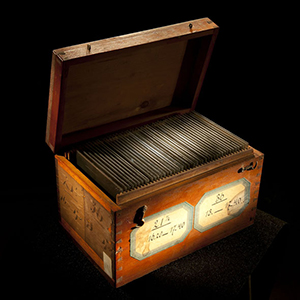Kapteyn's glass negatives

The glass negatives in this wooden box made Groningen astronomer Jacobus Cornelius Kapteyn world-famous. There are 86 boxes, filled with 2500 glass negatives that together have over 450,000 dots. Every dot represents a star in the southern hemisphere sky.
They were made by astronomer David Gill, of the Cape Town observatory. Gill did something unique: instead of drawing stars on a map, he photographed them. He hoped to be able to determine the position of the stars later on using the negatives. However, lack of money and manpower made this impossible.
But then Kapteyn came across the pictures. He had been appointed professor of astronomy in Groningen in 1878. However, there was no money to hire employees, or to buy instruments. There was not even an observatory. But these photographs offered him a chance to research the heavens anyway.
Kapteyn built a unique tool – the parallactic instrument – to analyse the negatives. His device contained a telescope with the same focal point as the telescope that had been used to make the shots. An assistant would place a picture in the holder and aim at a star. A protractor made it possible to determine the relative position. Just like measuring the sky star by star with a big telescope.
It took Kapteyn seven years to calculate the exact position and brightness of all 450,000 stars. It made him the greatest astronomer of his time. But secretly Kapteyn never liked collecting this data. Later in life, he wrote: ‘There is a sort of fate which makes me do all my life long just what I want to do least of all.’

